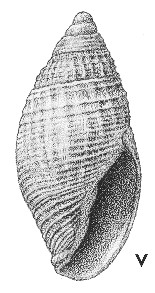
Revised descriptions of New Zealand Cenozoic Mollusca from Beu and Maxwell (1990)

 | Revised descriptions of New Zealand Cenozoic Mollusca from Beu and Maxwell (1990) | 
|
  (Pl. 37v): holotype, GS10193, CH/fl06, tip of Tarawhenua Peninsula, Pitt Island, Chatham Islands; Whenuataru Tuff, Waipipian (TM6828, GNS) |
Beu & Maxwell (1990): Chapter 14; p. 303; pl. 37 v.
Synonymy: Mitrithara granum Marwick 1928, p. 490
Classification: Conidae: ?"Clathurellinae", clade 13; Puillandre et al. 2008)
Description: Small for family (8 mm high), stout and ovate-biconic, with spire a little shorter than aperture. Spire outlines weakly convex, last whorl with evenly convex central area, contracting very gently to very weakly concave base; outer lip extends anteriorly beyond inner one to form widely open, oblique anterior notch directed slightly to left, lacking true anterior canal or fasciole. Sculpture of wide, very low subsutural fold (bifid on later whorls) separated from lower cords by wide, very shallowly concave sutural ramp; uppermost cord, at lower margin of ramp, slightly more prominent than most others; remainder of surface bears low, narrow, widely spaced, indistinct spiral cords, 3-4 on spire whorls and 25 on last whorl. Low, indistinct axial costae form very low nodules at sculptural intersections on spire whorls, but fade out at shoulder on last whorl. Aperture long and narrow, with simple outer lip bearing a very shallow anal sinus just below suture; inner lip bears 2 low but wide and prominent folds, occupying whole columella below parietal area. Protoconch dome-shaped, of 2 smooth whorls.
Comparison: Other species of Mitrolumna occur rarely throughout the mid-late Cenozoic; most have simple spiral sculpture. The rare M. brachyspira (Altonian, Oamaru) is particularly close to M. granum, differing in its fewer axial costae (about 15, compared with about 20 in M. granum). The relatively common M. gemmata and other living species have coarsely cancellate sculpture. We agree with Cernohorsky (1975, p. 232) that Mitrithara Hedley, 1922 is a synonym of Mitrolumna Bucquoy, Dautzenberg & Dollfus, 1883.
Distribution: Waipipian, Whenuataru Tuff, Tarawhenua Peninsula, Pitt Island, Chatham Islands (type and only known locality), uncommon. The Whenuataru Tuff contains a highly diverse fauna (more than 300 species of Mollusca; Maxwell in Cambell et al. 1993, table 4.30, pp. 140-145) that lived in a variety of hard and soft-bottom environments on the mid and outer shelf and in the upper bathyal zone. Bathyal taxa such as Volutomitra banksi (specimen in Pl. 27k), Coluzea aff. mariae and Galeodea triganceae occur mixed with shelf taxa in the cliff-top outcrop north of The Point homestead, west of Flowerpot Harbour, and less commonly at the tip of Tarawhenua Peninsula. The assemblage at Motutapu Point, north-eastern Pitt Island is, in contrast, dominated by hard-ground taxa such as Arcidae. The explanation of the mixed ecologies seems to be that Whenuataru Tuff represents an upper bathyal accumulation of tuff and shells in a variety of situations close to a steep, rocky coast, where shells could arrive from shallow as well as deep environments and from a variety of substrates.
Cite this publication as: "A.G. Beu and J.I. Raine (2009). Revised
descriptions of New Zealand Cenozoic Mollusca from Beu and Maxwell (1990). GNS
Science miscellaneous series no. 27."
© GNS Science, 2009
ISBN
978-0-478-19705-1
ISSN 1177-2441
(Included with a PDF facsimile file
copy of New Zealand Geological Survey Paleontological Bulletin 58 in CD version
from: Publications Officer, GNS Science, P.O. Box 30368 Lower Hutt, New
Zealand)